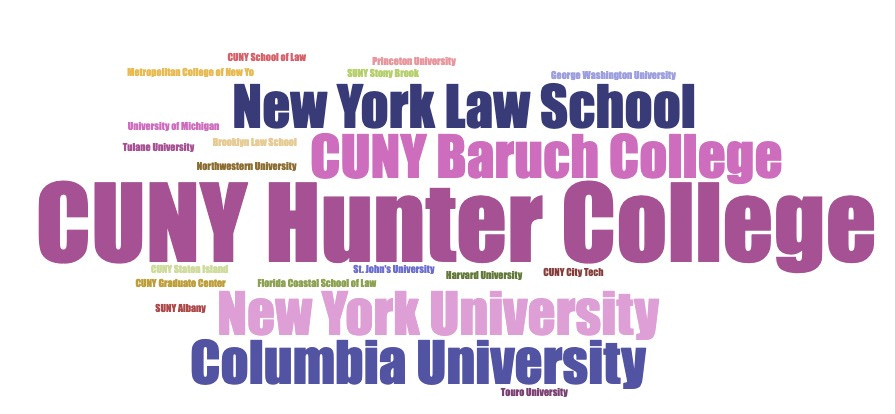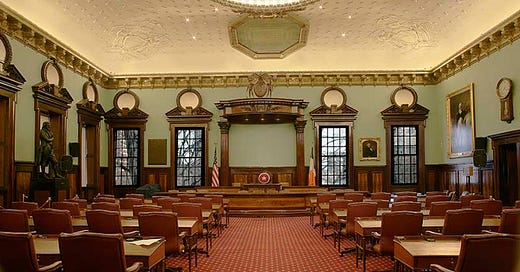The MNY City Council Data Project
Who represents you? What is their educational background? How strong are incumbency effects in our city council? Can we trust Legistar data?
Note from
: I’m incredibly pleased to present the work of the Maximum New York Research Group (first mentioned here). This post presents a new biographical dataset about the New York City Council, and a dedicated push to focus more civic tech and analysis on our legislature. A Maximum Thank You to Sebastian (who authored this post and project managed the whole enterprise), Dipali, Sangheetha, and Zach.New York’s city council is almost certainly the most influential municipal legislature in the country. The council’s 51 members are responsible for writing laws spanning land use, healthcare, transportation, education, and dozens more topics. They oversee the city’s sprawling government, which has a budget larger than 46 US states.1
But who are the members of our city council? A few months ago a group of Maximum New York alumni embarked on a research project to dive into their backgrounds. The goal of the research is to understand who our legislators are and develop a dataset for further analysis. We sought to answer questions like:
What’s the age distribution of city council members?
What educational and professional backgrounds are represented in the council?
How do experiences like working as a council staffer or being on a community board shape our council?
We performed online research into the biographies of all 201 city council members who appear in the city council’s official Legistar database. This contains all city council members from 1998 onwards, and a sprinkling of members from earlier legislative sessions. For each member, we scoured the internet for details about the person’s age, education, employment history, and community board membership. Most data came from a mix of historic voter guides, Wikipedia entries, and old news articles.
OUR DATA📊—> You can view the full dataset, or read on to view our preliminary findings; our analyses below reflect the city council through the 2022-2023 session. We will be updating it to reflect the new session that began this January. The linked spreadsheet contains sources for each datapoint.
Summarized Findings
Age
The mean age of a city council member is mid-40s, and the age distribution has remained remarkably consistent over the past two decades.
The chart below shows age statistics for the members of each council session as of the first day of the first year of the session.
Education
All but two members of the 2022-2023 legislative session had an undergraduate degree. The social sciences (particularly political science) dominate the chamber. There is just one member with an engineering degree.
Among NYC council members, Columbia has a strong alumni network in NYC. 10 city council members (20%) attended a CUNY college for their undergraduate degree.

Almost half of members hold a graduate or postgraduate degree, mostly in law and public administration.
Of those city council members who did go to graduate school, about one third went to CUNY.

Employment History
The vast majority of city council members worked for government or government-related employers (including legislatures and executive agencies) immediately prior to their election to office.
We then dug deeper into the “government” category. We found that almost a quarter of city council members in the 2022-2023 legislative session were employed by another city council member immediately prior to their own election. These former council staffers were typically in senior positions like chief of staff or legislative director.
The proportion of city council members with this employment background has significantly increased since 2010, when term limits were introduced. We hypothesize that term limits increased turnover of city council districts (no surprise, perhaps), and that staffers are often well positioned with political connections to win the seat of their outgoing boss. This could have interesting implications for the efficacy of term limits in bringing in “fresh blood” and giving opportunities to outsiders.
Community Board Membership
New York’s 59 community boards are an entry point for many people into local politics. These are district-specific bodies with members appointed by the relevant borough president and city council members to advise city government on land use, licensing, and other local issues.
We find that a large minority of city council members were previously members of a community board at some point before being elected to the city council. From 2002 to 2021, this was a remarkably consistent 36% of council members, with a surge up to 41% for the 2022-2024 legislative session.
A disclaimer
We put a lot of effort and love into collecting this data, and did our best to double-check everything. However, as with any data collection effort like this, some data points were ambiguous, difficult to find, or may simply suffer from data-entry errors. We also performed data normalization to cluster together similar fields of study and assign employers to individual “industries”. If you notice anything in the dataset that needs correction, please contact us.
What’s next
Our dataset is now available for any researcher to analyze. Ideas we have for future analysis include:
Joining with legislative productivity data (such as number of bills introduced/passed) to identify correlations between council members’ backgrounds and their impact once elected.
Analyzing membership of council committees to see how well council members’ backgrounds match with the topics they are overseeing and legislating about.
If you have suggestions for future directions for this research, let us know in the comments. We would welcome collaboration with other people who are interested in understanding our city council better.
Subscribe to Maximum New York for updates on future research.
About the researchers
This was a joint project by a group of Maximum New York alumni, who each write their own newsletters about the city:
- writes Sidewalk Chorus
- writes Mapping NYC
- writes Metro Mosaic
Zachary Thomas writes
KFF, Total State Expenditures, 2022




